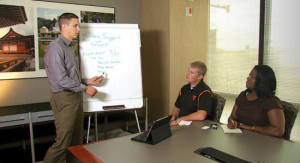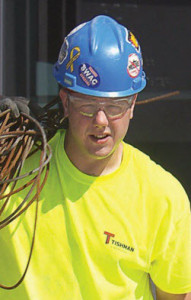Diversity/MBA Magazine: Recruiting Veterans
In the Job Market for Veterans, Employer Knowledge is Power
By Sue Stolov, Diversity MBA Magazine

Jon Zazami, working at Caterpillar Financial in Nashville, Tenn. Zagami, who works in account services, is a wounded veteran (Post Traumatic Stress Disorder and Traumatic Brain Injury). His brain injury led to him having a stroke at age 20. He wishes employers would “curb the snap judgments as soon as you hear someone was injured in combat.”
Every day we hear about another company launching an effort to hire more Veterans, and that is great news. Veterans bring diversity to a company team—their ability to work with diverse teammates and their own experience with other cultures is often unparalleled. So we all have to ask, why is unemployment for veterans still so high? What is happening in between our plans to hire veterans and the actual hire? Is there a road block that perhaps we have not thought about?
How many of us know veterans? Research says not many. The number of CEOs who served in the military has dropped notably over the past 30 years. According to a Harvard/Boston University research team, in the 1980s, 60 of every 100 CEOs had served in the armed forces. Now, only eight in a room of 100 have served. In fact, when he was Commander of the U.S. Army Warrior Transition Command, Brig. Gen. Darryl Williams once told me he gave a speech to a roomful of 300 CEOs and executives in the financial industry and asked for a show of hands as to who had served in the military. Not one raised a hand. This, we all know, is a challenge for those in diversity because, as research in the American Sociological Review points out, they battle against the natural tendency of individuals to hire people with similar interests and backgrounds.
So what happens when we don’t know anything about a “type” of person? We “type” them and fill in our knowledge void with what popular culture tells us. I have news for you, “Zero Dark Thirty,” “Battleship” and “Act of Valor” don’t tell us anything about what the average veteran is like. But they sure are fun to watch. And great entertainment. But movies are not real. If we are not learning about veterans from movies, perhaps we are filling in our knowledge void with news reports. Having worked as a reporter for many years, I can tell you the definition of news and that is something that is different and unusual. Unusual is the key word here. Unusual is not normal. That is why it is news.
Recently, the U.S. Army Warrior Transition Command set out to take a look to see how they could improve employment opportunities for wounded veterans rejoining their local communities. They asked me to produce a video as part of this effort. The first thing I would normally do as research for a project like this would be to interview 40 or so HR executives and see if I could learn why veterans—and wounded Veterans in particular—were not getting hired. Early in my research, I discovered that the Society for Human Resource Management had already done this. In fact, over a period of two years, more than 1,400 of their 250,000 membership had completed surveys about hiring Veterans. Among their results:
- 53% don’t know if workers with PTSD are more likely to commit acts of violence in the workplace
- 52% don’t know if it is costly to accommodate workers with PTSD or traumatic brain injury (TBI)
- 70% don’t know if workers with TBI will need help with tasks that involve reading
- 42% admit PTSD or other mental health issues are a challenge when hiring veterans
The data shows that most employers have no idea what someone with PTSD or TBI would be like to work with, and they have no idea how someone with PTSD or TBI needs to be accommodated.
Since so few of us know veterans, I set out with this video to introduce people to veterans working on the job in typical businesses that you would find on any street in the USA, blue collar and white collar. Veterans who could explain, in their own words, how their injuries impact their work life. I wanted people to make their own conclusion. Would they want a veteran sitting at the desk next to them?

William Plotner, construction worker (TBI) working for Tishman Construction Corporation in New York City. Plotner says the Army has taught him how to overcome his injuries to the point where people at his place of work, don’t even know he was injured.
More importantly, I interviewed their bosses. Two of the veterans had been diagnosed with PTSD. In both cases, their immediate bosses had no idea either employee had PTSD until I told them (interestingly, in at least one case, the HR department knew, but did not pass the information along). Their performance on the job had given no indication.
I also set out to see if the misperceptions indicated by the data were true. I interviewed experts in Washington, DC. I went to the head of the Traumatic Stress Research Program at the National Institute of Mental Health to learn about PTSD. I learned from Dr. Farris Tuma that more people in the United States have PTSD from a motor vehicle accident than from combat. That’s right, the person working in the cubby next to you may have PTSD, and that person may not have access to the same care a veteran would receive. Dr. Tuma said that thinking someone with combat-related PTSD would be violent is as ridiculous as thinking someone who survived a car crash would go on a car driving rampage.
Next, since the survey results showed that 52 out of every 100 HR executives have no idea what it would cost to accommodate someone with PTSD, I went to the Department of Justice and asked: what kind of accommodations does a business need to make to accommodate a wounded veteran, and how much does it cost? Eve Hill, Sr. Counselor to the Assistant General for Civil Rights, said accommodations have to be reasonable and not create undue hardship on a business. She added that most accommodations cost less than $500, and many cost nothing.
Besides those experts, in this video you’ll also meet 28-year-old Jon Zagami who told the HR department during his interview, “Yes, I have PTSD. I have night terrors, but that does not mean I’m not going to get up when my alarm goes off. And yes, I get migraines, but so does the colleague next to me, and I have learned how to treat it.”
Zagami is probably the healthiest employee where he works, because he learned how to take care of his body as he learned to overcome his injury. And his boss told me that colleagues twice Zagami’s age are continually coming to Zagami for advice. Zagami himself is continually surprised when that happens, and he speculates it’s because they appreciate his unique perspective and experience. And, the diversity he brings to the job.
So can we say without a shadow of a doubt that veterans, particularly post-9/11 veterans, those most closely associated with PTSD, are not getting jobs because of misperceptions and stereotypes that HR executives and middle-managers bring to the interview table? It is speculation, but it may also be a matter of connecting the dots. And, there are strong indicators. Unemployment is much higher for younger, post-9/11 veterans(in January 2013: 7.6 percent for all veterans, but 11.7 for post-9/11), and the Society for Human Resource Management survey results are a clear indication of what interviewers may be thinking. Consequently, it’s a conversation we need to begin and a discussion we need to have with our hiring executives and middle managers.
We need to knock down stereotypes and change attitudes. Maybe I am going to have to make a movie.
Susan Stolov is a television producer and CEO of Washington Independent Productions, a company that specializes in changing people’s attitudes through video and social media.
- Show “Hire a Veteran: Obstacles & Solutions” to middle manager and HR executives. Allow it to begin a discussion about myths and misperceptions. The video is available at: WTC.army.mil/employers. For DVDs of the video, write: Sue@washingtonindependentproductions.com or call: 202-230-7040.
- Invite a veteran to come and speak after you show the video. Give people a chance to ask him/her questions about their background, why they joined the service, what challenges they overcame and what their successes were.
- Check out the U.S. Army Warrior Transition Command’s employers’ page. There you will find resources about interviewing veterans, accommodations in the workplace and PTSD: WTC.army.mil/employers.

